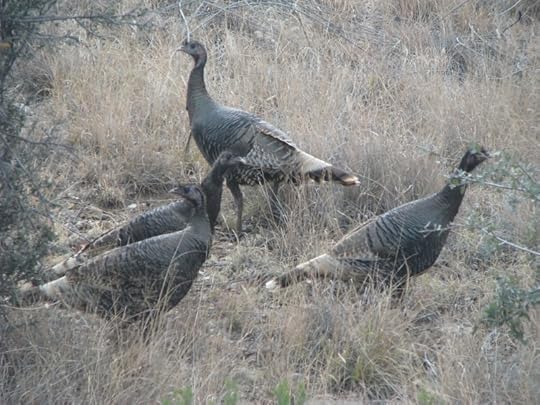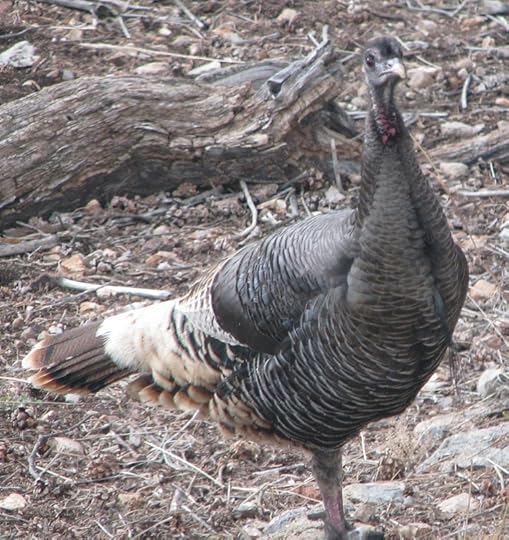Kate Rauner's Blog, page 18
November 25, 2021
Happy Thanksgiving #turkeyday
Happy American Thanksgiving, and to our Canadian friends, why not roast another turkey?
 Birds in my backyard, in the mountains of Southwest New Mexico, stay alert and escape the dinner table.
Birds in my backyard, in the mountains of Southwest New Mexico, stay alert and escape the dinner table.

Enjoy your holiday 
November 20, 2021
NASA’s Next Big Space Telescope to Launch in December :) #astronomy #NASA #JamesWebb
Webb will be the premier observatory of the next decade, serving thousands of astronomers worldwide. It will study every phase in the history of our Universe, ranging from the first luminous glows after the Big Bang, to the formation of solar systems capable of supporting life on planets like Earth, to the evolution of our own Solar System… extending the discoveries of the Hubble Space Telescope with longer wavelength coverage and greatly improved sensitivity. NASA
Innovative and international, the James Webb folds up like origami inside its payload for its rocket-ride into space, then deploys gold-coated beryllium mirrors. It will orbit the Sun, not the Earth! Farther away than our own Moon (which does, of course, orbit the Earth,) Webb will occupy a Lagrange Point.
The L2 is one of several points in space where the gravitational interplay of the Sun and Earth precisely equal the centrifugal force of a much smaller third body, such as the Webb telescope. It’s a delicate balance, and the telescope won’t sit exactly at the L2 point, but orbit around it as that point orbits the Sun. Kinda wild looking orbit, but a great place for a telescope looking outward to the stars.
You can have your own Webb telescope! At least, you can craft your own paper model. From NASA and telescope enthusiasts from 4th Graders up, download the PDF files, print on heavy or standard paper as described, and assemble.

Have fun as you wait for the James Webb launch. 
November 11, 2021
Bioluminescence #sciku #haiku #science #poetry
You think fish eat me
But I called them for a ride
My Living Light app
Darwin encountered ocean bioluminescence in 1832: “The sea from its extreme luminousness presented a wonderful & most beautiful appearance; every part of the water…glowed with a pale light.”
Satellites can track these glowing seas today, trillions upon trillions of bacteria called Vibrio harveyi, looking to pass through fisg guts and sink deeper into the ocean
November 9, 2021
Holy Guacamole! Colonize Saturn’s Moon Paperback Half Off Today #reading #scifi #sciencefiction

Kidnapped settlers on a hijacked spaceship awake on Titan, a deadly frozen moon. The cult’s leader seeks a perfect world, but utopia turns to catastrophe. A young engineer must defy the leader to survive, but can he save all their lives?
Buy the paperback now for 49% off the regular price in the USA store – maybe other countries too. I don’t know because this is one of Amazon’s surprise discounts. It could disappear any minute.
The paperback sale wasn’t up to me, but I can offer this: Kindle edition today and through November is only 99 cents!
Real readers say: Dynamic story – Engaging characters – Feel like you were there – Devoured this book.
Discover a riveting mix of science and society on Saturn’s deadly frozen moon. If you love gripping science fiction with twists and turns, you won’t want to put it down.
Click to Buy Now if You Dare.November 5, 2021
What Really Flattened Siberia in 1908? More Recent Event Offers Insight #asteroid #meteor #astronomy #explosion
One of my favorite podcasts tackled the Tunguska event, and this classic mystery seems well in hand. A huge explosion occurred over a remote and sparsely populated area in Siberia in 1908, and data was collected around the world.
Photographs and eye-witness accounts came from years later, but there was real-time data too:
Seismic readings taken from all over Eurasia indicated that Tunguska experienced a 5.0 earthquake from the shockwave.The barometric impact of the shockwave was recorded nearly everywhere as an atmospheric pressure wave of infrasound, even as far away as Washington, DC on the other side of the planet.Throughout Eurasia, the night sky was illuminated, consistent with the upper atmosphere ice crystals that would be expected to be created from an explosion of this magnitude. SkeptiodA huge meteor has seemed a likely explanation for a long time. In January of 2018, NASA’s Ames Research Center in California held a workshop to apply a recent calibration to the analysis: the 2013 event over Chelyabinsk, Russia. We’ve got great information on that strike, including videos.
Past speculation on Tunguska embraced a lot of alternatives to a meteor, from aliens to secret early nuclear bomb experiments, but using what we learned from Chelyabinsk, the Tunguska event has been modeled “within the bounds of accuracy — to any practical degree — to confidently assert that it was the entry and explosion of a hypersonic superbolide, many times the size and with many times the energy of the similar Chelyabinsk event. Even though we don’t know everything, we do know that.”
Download your own copy of the NASA Workshop’s conclusions by clicking here.
Thanks to Skeptoid for their episode.
Sorry about no aliens…
November 4, 2021
End of the World? All New Adventure Story on Amazon’s New Vella #shortstories #amreadingfantasy
Return today to the thrilling days of… serials. From Dickens to Buck Rogers to me  serials are classic, and Amazon now offers “stories told one short episode at a time.” What do you think? Does this fit your busy day? Try it out with my tale of doomsday and con artists: Armageddon, One Sucker at a Time.
serials are classic, and Amazon now offers “stories told one short episode at a time.” What do you think? Does this fit your busy day? Try it out with my tale of doomsday and con artists: Armageddon, One Sucker at a Time.
 Armageddon, One Sucker at a Time
Armageddon, One Sucker at a TimeMy story’s final episode’s been posted, so binge straight through or savor the tale one episode at a time, your choice.
Flint Benning has an underground stash of freeze-dried food to last for decades, a career in black operations, and expertise in survival. Surely the world’s elite will pay him for the ultimate Armageddon hide-away. So why is he bankrupt? Flint will die a pauper in the rubble of humanity’s despair, until he meets dooms-dayers with more imagination. The end of the world is going to be fun. Armageddon on Amazon Vella
Science Fiction, Fantasy, Dystopian, Teen & Young Adult, Action & Adventure
New to Vella? Scifi, fantasy, romance, historical fiction, humor, mystery, LGBT fiction, and more – stories in all genres. Read the opening episodes of any story for free, then unlock more enticing episodes with purchased tokens. Only pay for what you read!
November 3, 2021
Oh Boy, Let’s Hurl Rockets into Space with Mechanical Centrifuge #space #satellite #rocket
Suppose you want to launch your payload into orbit on the cheap, with less environmental impact than those big rockets dominating the space industry? Have I got the answer for you (well, not me, exactly, but a California company.) Here comes another revolution in spaceflight.
I can imagine all sorts of problems getting the timing right – you don’t want to clip the edge of the centrifuge – but those are merely engineering details.
SpinLaunch expects to perform the first suborbital tests of a prototype of its centrifugal system for launching small satellites later this year from New Mexico. SpaceNews
They’re set up in (practically) my backyard: Spaceport America. That announcement comes from last January, so they better get their tails in gear to launch in 2021. There’s no date on theri list of job openings, but maybe you can nab one: SpinLaunch
October 28, 2021
Elephants, Poachers, and Evolution #evolution #elephant
Humans have intentionally bred new versions of domestic animals, but we do it to wildlife too. Even to large animals. Even to elephants.
 Tusks have been collected and hunted forever, but modern weapons make hunters very efficient
Tusks have been collected and hunted forever, but modern weapons make hunters very efficientA recent study “highlights the ubiquity of human influence across the tree of life,” says Shane Campbell-Staton, an evolutionary biologist at Princeton University, who published the findings on October 21 in Science.
Most of Mozambique’s elephants were killed by poachers across the 1980s, harvesting their tusks for sale on the black market. The surviving females are those that naturally have no tusks. As a result, the almost-overwhelming cull creates tuskless elephants. I hope that’s enough to save the species, but the world around them will be changed too.
Tusks are a bit like a Swiss army knife for elephants, Campbell-Staton says. Elephants use their tusks for a variety of tasks, including stripping bark off of trees and digging for subterranean minerals and water sources. These activities can open up habitat for other animals, destroy trees, and allow other plant species to grow—and have a myriad of other complex ecological effects. “If elephants don’t have this key tool to provide these important services, then what happens to the rest of the ecosystem?” Popular Science
I’ve read about places in America where organizations sponsor rattlesnake hunts. A rattlesnake’s bite can be fatal to humans and animals, so killing as many as possible seems like a good idea. But the rattlesnakes most likely to be caught and killed are those that rattle. While hiking, I’ve run across one or two such snakes every year or two, and thankfully they rattled to warn me off. No bites. I wonder if the snakes in those heavily hunted places are being bred to not-rattle. Maybe we humans deserve what we get.
The study of Mozambique’s elephants is summarized on Popular Science.
October 22, 2021
My Kind of Space Travel – with a glass of Champagne #space #spacetravel #travel
Drift quietly upward, up to the black of space, high enough to see the curvature of the planet, and enjoy the view for hours. There would be no zero-g shenanigans, but a comfy bar and toilet facilities may make up for it.
Check out an artist’s conception of the flight:
This is World View, and it has competition for your leisure dollar in the world of Stratospheric Ballooning. So the flight is part of a larger vacation package:
Spend 5 days experiencing the biodiversity of the world’s largest rain forest with local guides then float up to take in its grandeur and fragility from 100,000 feet. World View
Initial flights will take off from a more mundane location: Page, Arizona, near the Grand Canyon, which is hardly mundane, so take the rest of your vacation in the vicinity. There seem to be other launch locations contemplated, but I didn’t give the company $500 to reserve me a seat on the future flight. I did sign up for their newsletter, so maybe I’ll learn more than the website offers.
World View, based in Tucson, Ariz., announced Oct. 4 it is developing a passenger capsule that will be carried aloft by balloons to altitudes of about 30 kilometers. The Explorer Space Capsule will host eight passengers and two crew for flights lasting 6 to 12 hours, giving people a view of the Earth the company argues resembles that seen from space. Tickets will cost $50,000 per person, with World View providing what it calls “flexible financing options.” The company expects the first flight no earlier than early 2024. spacenews.com
The space balloon industry has a technical quandary to deal with: hydrogen or helium? The supply of helium has its ups and downs, and if efforts to fight climate change reduce natural gas drilling (helium is a byproduct of radioactive decay underground) shortages could be more frequent and helium can be pricey. Hydrogen is plentiful, but it explodes. Or rather, it can explode, Hindenburg-style, if you’re not careful.
Another company, Space Perspectives, thinks they have safety worked out with a 650-foot-tall hydrogen-filled balloon for eco-friendly space travel. They’re sold out for 2024 (flights are planned to begin late in the year) so someone believes them.
So, if you’ll be high enough to experience black space and view the curvature of the Earth, why no zero-g? Because there’s plenty of gravity 100,000 feet above the planet’s surface. You know that, right? Astronauts in orbit aren’t outside our planet’s gravitational field, they’re in free fall. Einstein’s equivalence principle says, you can’t tell the difference, and it seems he was correct.
I sometimes wonder, will equivalence apply to biology too? Travelers to Mars will experience as close to actual zero-gravity as anyone is likely to achieve, since the trip is bound to include periods of coasting at constant velocity far from any planet. Will the effects be different from what astronauts on the International Space Station experience? I guess the answer is “no” because the fluids and tissues in their bodies won’t know the difference. But gravity is a strange beast in the quantum zoo, so I still wonder.
My Kind of Space Travel – with a glass of Champaign #space #spacetravel #travel
Drift quietly upward, up to the black of space, high enough to see the curvature of the planet, and enjoy the view for hours. There would be no zero-g shenanigans, but a comfy bar and toilet facilities may make up for it.
Check out an artist’s conception of the flight:
This is World View, and it has competition for your leisure dollar in the world of Stratospheric Ballooning. So the flight is part of a larger vacation package:
Spend 5 days experiencing the biodiversity of the world’s largest rain forest with local guides then float up to take in its grandeur and fragility from 100,000 feet. World View
Initial flights will take off from a more mundane location: Page, Arizona, near the Grand Canyon, which is hardly mundane, so take the rest of your vacation in the vicinity. There seem to be other launch locations contemplated, but I didn’t give the company $500 to reserve me a seat on the future flight. I did sign up for their newsletter, so maybe I’ll learn more than the website offers.
World View, based in Tucson, Ariz., announced Oct. 4 it is developing a passenger capsule that will be carried aloft by balloons to altitudes of about 30 kilometers. The Explorer Space Capsule will host eight passengers and two crew for flights lasting 6 to 12 hours, giving people a view of the Earth the company argues resembles that seen from space. Tickets will cost $50,000 per person, with World View providing what it calls “flexible financing options.” The company expects the first flight no earlier than early 2024. spacenews.com
The space balloon industry has a technical quandary to deal with: hydrogen or helium? The supply of helium has its ups and downs, and if efforts to fight climate change reduce natural gas drilling (helium is a byproduct of radioactive decay underground) shortages could be more frequent and helium can be pricey. Hydrogen is plentiful, but it explodes. Or rather, it can explode, Hindenburg-style, if you’re not careful.
Another company, Space Perspectives, thinks they have safety worked out with a 650-foot-tall hydrogen-filled balloon for eco-friendly space travel. They’re sold out for 2024 (flights are planned to begin late in the year) so someone believes them.
So, if you’ll be high enough to experience black space and view the curvature of the Earth, why no zero-g? Because there’s plenty of gravity 100,000 feet above the planet’s surface. You know that, right? Astronauts in orbit aren’t outside our planet’s gravitational field, they’re in free fall. Einstein’s equivalence principle says, you can’t tell the difference, and it seems he was correct.
I sometimes wonder, will equivalence apply to biology too? Travelers to Mars will experience as close to actual zero-gravity as anyone is likely to achieve, since the trip is bound to include periods of coasting at constant velocity far from any planet. Will the effects be different from what astronauts on the International Space Station experience? I guess the answer is “no” because the fluids and tissues in their bodies won’t know the difference. But gravity is a strange beast in the quantum zoo, so I still wonder.



